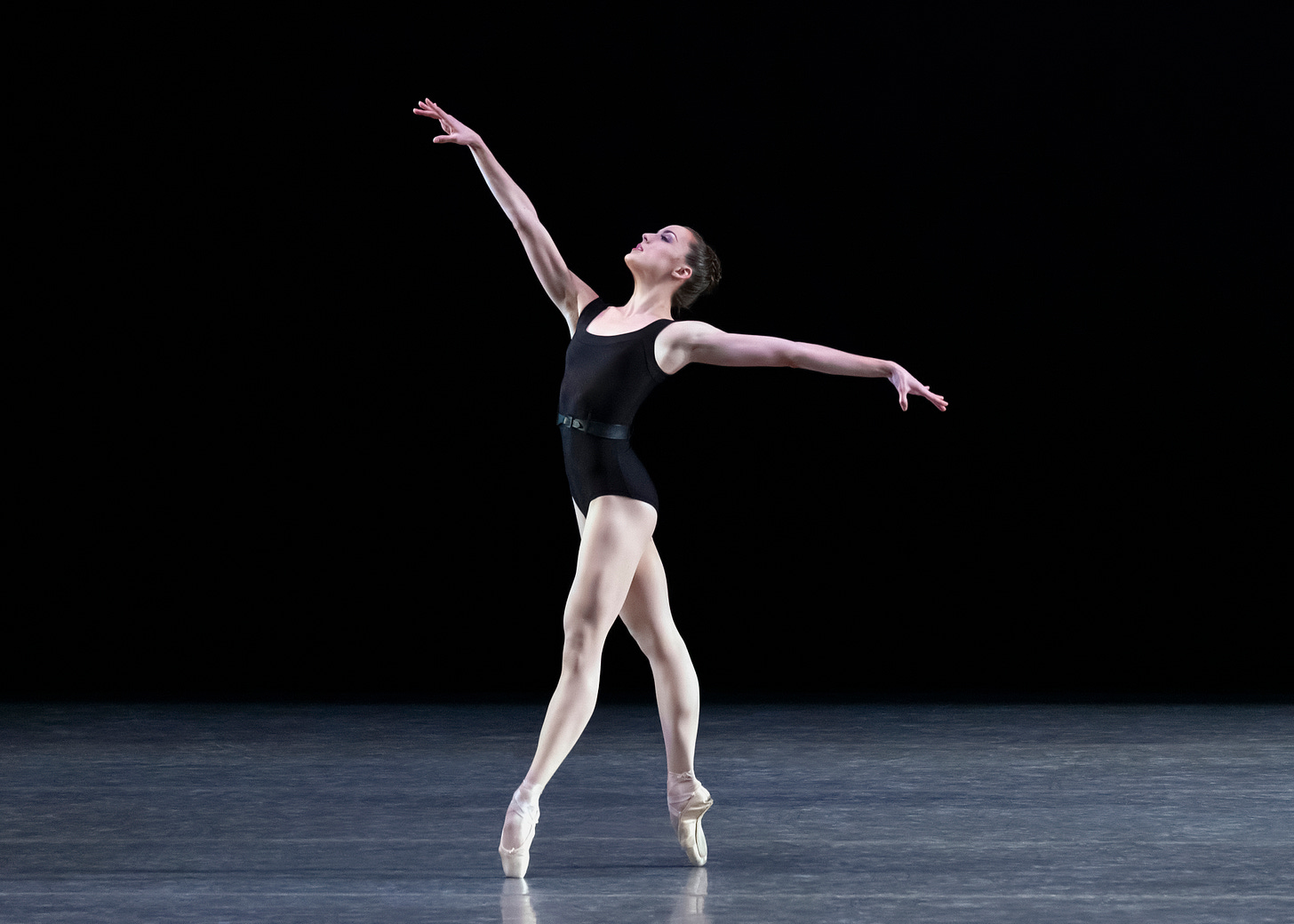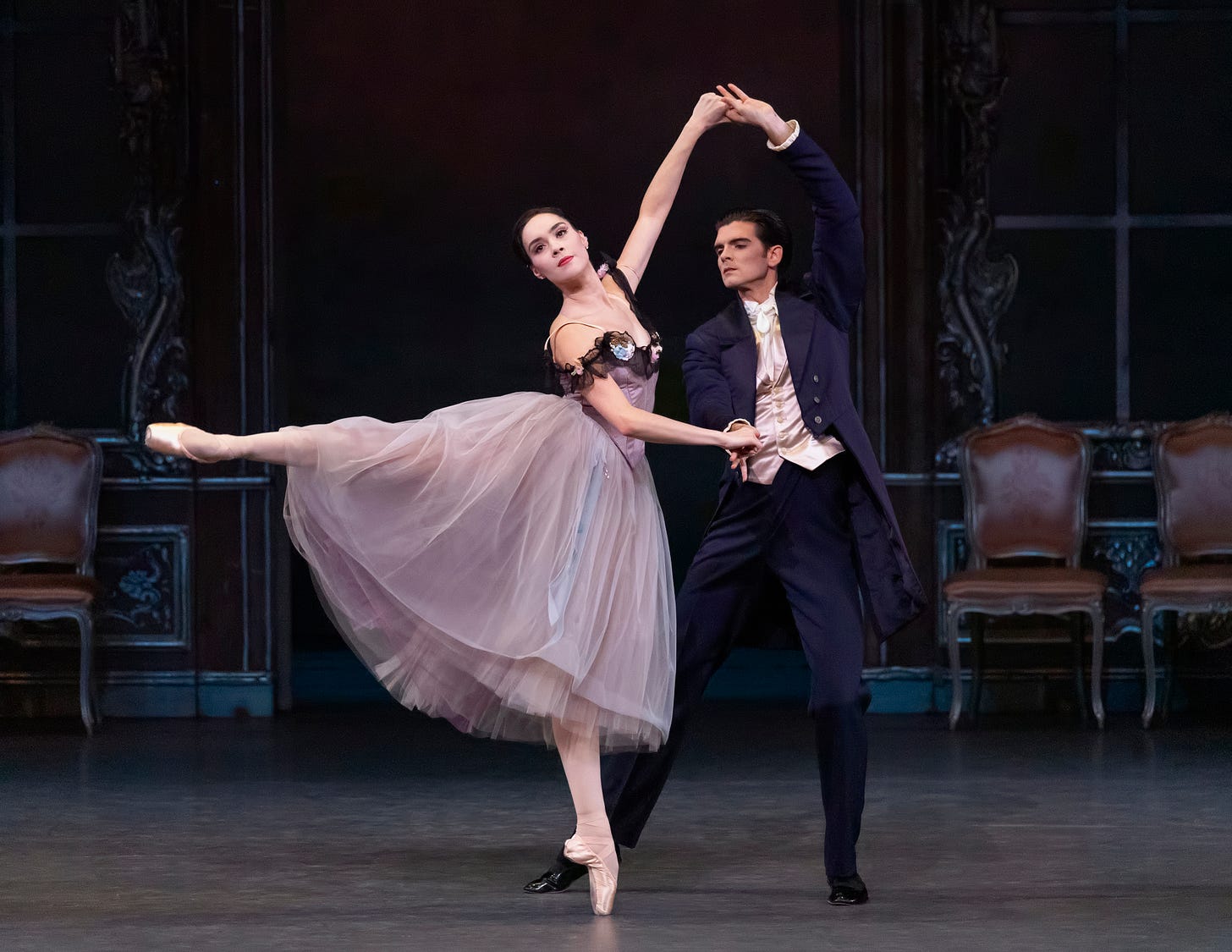Love in the Afternoon
On "Liebeslieder Walzer" and "The Four Temperaments" at New York City Ballet
Tyler Angle, Tiler Peck, Unity Phelan, Roman Mejia, Peter Walker, Mira Nadon, Megan Fairchild andAdrian Danchig-Waring in George Balanchine’s Liebeslieder Walzer. Photo by Erin Baiano
There are few works more beloved in the Balanchine repertory than his ballets “The Four Temperaments” (1946) and “Liebeslieder Walzer” (1960). Each represents a kind of paragon of Balanchine’s various inclinations, and even, one could say, of his philosophy of dance. “The Four T’s,” as it is known, is the forerunner of ballets like “Agon” and “Episodes,” in which he radically, and with great confidence, broke the balletic line, forging a new kind of classicism. It is a classicism that reflects the hard edges and angles—the lack of sentimentality— of the twentieth century, and of his adopted home, the city of New York.
In contrast, “Liebeslieder” reveals his great profundity as a dramaturg, the way he spun endless stories out of dances, particularly if they involved a man and a woman. How many thoughts can a waltz reveal? An infinite number, it turns out.
A program that includes both is an evening devoted to the very bones of New York City Ballet. The stakes are high, particularly at a time when the troupe is passing through a major generational shift. On February 6, the casts of both ballets included several débuts, and inevitably there were performances that lacked the fullness they may one day acquire, and dancers that seemed mis-cast. But the impact of both ballets was still strong; not only are the bones good, but the dancing was often, though not universally, bold, confident in style, even, in certain moments, luminous.
“The Four Temperaments” took some time to get going. Both the first and second “theme,” set to the short opening sections of Paul Hindemith’s score for piano and orchestra, each danced by a different couple, were cautious and slow. The choreography, much of it shown in profile, the better to reveal breaks in the line, stinted on the angularity and clarity that make this ballet feel like a microscope through which the basic shapes of ballet are examined: the turned-out body, the pointed foot, the interlocking of limbs.
Olivia MacKinnon, an admirable and can-do type of dancer, seemed miscast in the second of these duets, her natural bubbliness at odds with the sharp, impolite choreography, full of hip thrusts, splits, and decisive sweeps of the arms. (The section also introduces a funny, bent-arm “Egyptian” walk that returns in the finale of the ballet.) But in the third duet, Sara Adams (a début) and Davide Riccardo refocused matters with the yielding, outstretched, introspective quality of their dancing, making much of the choreography’s many foldings and unfoldings and a clever moment in which the man spins the woman around as she stands on one pointed, bent leg. He looked as if he were plucking the strings of a double bass.
Emily Kikta in George Balanchine’sThe Four Temperaments. Photo by Erin Baiano
Sebastian Villarini-Vélez, in the “Melancholic” section—a series of droops and falls—lacked precision or urgency. But in the “Sanguinic” section, tall, strong Isabella LaFreniere blazed with such force that she almost knocked herself off-balance. (It was exciting.) As if that were not enough, Emily Kikta, even taller and more blazing, burst onstage in “Choleric” with such wildness that at first she was ahead of the music. As in the Amazonian role “Rubies,” this is a woman who dominates all the men who attempt to partner her, grasping at the very tip of her outstretched limbs. Kikta captured that electricity—in fact she appeared almost radioactive. Once she quieted down just a touch, she found her way back to the piano melody (well-played by Stephen Gosling) slicing her way through the other dancers like a sibyl announcing a prophecy. “Listen to me,” she seemed to say with her arms.
After the intermission, the stage had been transported to a nineteenth-century Viennese parlor, illuminated by a gentle glow from the chandelier, a piano in one corner, French windows opening up to the evening air. The situation depicted in “Liebeslieder Walzer,” set to Brahms’s two piano works of the same name, is a house party, where four couples, visibly close friends, listen to and dance to music. The two pianists (Andrews Sill and Susan Walters) play four hands, accompanying four singers. Everyone is onstage, and the dancers acknowledge the musicians as part of their world; at the end, as the lights darken further, they sit and simply listen, applauding the performance. I wish the piano, and the pianists, had been more visible, and that the sound of the keyboard had been more present. The quality of the singing was, as usual at the ballet, mixed.
The dancing in “Liebeslieder” is both introverted and extroverted. The first half is performed in long, off-the shoulder dresses and heeled shoes, with the men wearing gloves. The dancers mostly address each other. There are flirtations, conflicts, secrets and sadnesses, as well as moments of pure friendship, as when the dancers form a tight circle, arms around each other’s shoulders, and spin around and around. The second part is more outward and more balletic: the steps are distilled and outstretched, and the drama becomes less personalized. The dancers in this half don’t watch each other—they perform for themselves.
But in both sections there are small revelations, moments that alter the temperature and heart-rate of the ballet. Stories emerge. One couple, in particular, danced here by Tiler Peck and Tyler Angle, seems haunted by a sadness. He reaches for her arm, she walks away. The two stand with their faces very close; he shades his eyes from her. Until finally, she swoons into a faint, and he lifts her, horizontally, her arms crossed on her chest. Is it a prefiguration of death, or of the death of their love? This role was originated by Violette Verdy, one of the company’s most dramatic ballerinas. It takes dancers of maturity and subtlety, like Peck and Angle, to render its quiet bleakness without overdoing the drama. They succeeded.
Mira Nadon and Peter Walker in George Balanchine’s Liebeslieder Walzer. Photo by Erin Baiano
In the dances for a second couple, performed here by Unity Phelan and Roman Mejía (a début), the woman seems almost lost in her own thoughts. Gently, he spurs her to action, with a slight push at the small of her back that sends her into a deep lunge, reaching forward, toward the furthest corner. When she once again falls into a daydream, he taps her shoulders and she joins him in a faster dance. Later, he orbits around her, again and again, like a planet around the sun. Phelan, whose expressive qualities have blossomed of late, was beautifully pure, pausing as if to listen with her whole body; her little balances in arabesque in part two also had that quality, as if she were thinking, “what now?” But their most beautiful moment, the emotional pinnacle of the ballet, in which her partner lowers her toward the floor, and she circles one leg underneath herself only to rise again on pointe—I’ve always thought she looked like a ship on the highseas—didn’t quite work. The fall and rise weren’t there, the circle of the leg lacked the necessary voluptuousness. Mejía, whose ardor had been so winning in part one, hasn’t yet smoothed out the partnering challenges of the moment. It is a shame, because it is one of the ballet’s most emotionally resonant moments, even if we will never know what, exactly, it means.
Unity Phelan and Roman Mejia in George Balanchine’s Liebeslieder Walzer. Photo by Erin Baiano
The revelation of the night, for me, was Mira Nadon in the role originated by Diana Adams. Both she and her partner, Peter Walker, were débuting. From the moment she walked on, Nadon seemed to have entered another reality. She has the ability to appear completely enveloped in the atmosphere of a ballet, like an actress in a movie. This impression was further augmented by the amplitude of her dancing; she filled the music with her movements, as if swimming through it. When Walker whispered in her ear as they crossed the room, you could almost feel her blush; the pleasure of their intimacy registered in her shoulders as well. Her pauses were filled with the pulse of thought.
This is, in many ways, a ballet about women. The men activate them, orbit around them, yearn for them. But it is the women’s feelings and mental states that count. It is through their dancing that we are drawn into Liebeslieder’s intimate world, suffused with quiet drama and distilled emotion. We experience it, and them, through Balanchine’s eyes, as infinitely interesting, complex, and elusive beings.








I enjoyed this review a lot. Four Ts is a great favorite of mine. I wish I could have seen this performance. Your review and photos have made images out of words.
Ms. Harss, I do hope that you will continue to publish these reviews. I learn a great deal from your knowledge, perception, thoughtfulness, and precise observations. Kathy in DC